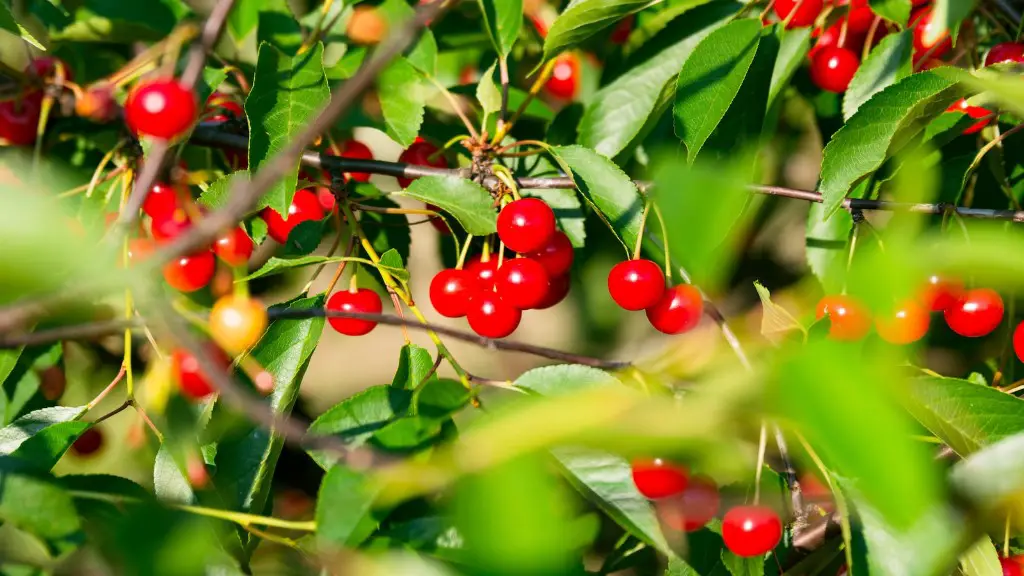When one thinks of cherry trees, they may be expecting a small, shrub-like tree. But, cherry trees can be quite large, depending on the species. They can range from 15 to 30 feet in height and have a canopy of 15 to 25 feet wide. The average cherry tree can live for about 25 years, but some varieties have been known to live for more than 100 years. The life expectancy of a cherry tree is based on the climate and the care it receives.
The size of a cherry tree depends on the variety. In colder climates, like the northern United States and Canada, dwarf varieties are most commonly used as they are better suited for survival in cold winters and are generally smaller. In warmer climates, larger varieties like the sweet cherry tree can be grown. Sweet cherry trees can reach heights of up to 30 feet, with some reaching up to 50 feet.
Cherry trees need a lot of sun, so they are best planted in full sun locations. They do not do well in shaded areas, so they should not be planted in the shade of other large trees. They also thrive in soil that is well-drained and has a pH between 5.5 and 6.5. Cherry trees should be fertilized every year in late winter or early spring to ensure that they have plenty of nutrients for the growing season.
Cherry trees are usually pruned in late winter or early spring, with the most important pruning taking place when the tree is young. Pruning should be done to encourage healthy growth and ensure that the tree has enough sunlight, water and nutrients to encourage growth, as well as to remove dead or diseased branches. Over-pruning can be damaging, so it is important to consult with an experienced arborist before undertaking any pruning.
There are a few diseases and pests that can affect cherry trees. Fire blight is a bacterial infection that is spread by aphids and other insects, and can cause wilting, die-back and even death of trees. It is important to keep an eye on your cherry tree for signs of fire blight, as well as treating it with a fungicide in order to prevent it from spreading. Cherryleaf spot is another common disease of cherry trees, which is caused by a fungus and is characterized by spots on the tree’s leaves.
Cherry trees can provide a beautiful addition to any garden, and they are easy to care for when grown in the right conditions. A cherry tree can add color and shade to an outdoor space and is sure to be enjoyed for many years to come.
Growth Requirements for Cherry Trees
Though cherry trees may appear to be tall and tough on the outside, these trees actually require very specific growth requirements in order to survive. All cherry trees need full sunlight, well-drained soil, and relatively acidic soil with a pH level of 5.5-6.5. Additionally, cherry trees should be well watered throughout the growing season and maintained with regular fertilization.
When it comes to planting a cherry tree, space is also important. Depending on the variety, cherry trees may need little to a lot of space to allow for adequate growth. When planting, it is best to consult an expert to determine how close together two cherry trees should be planted, as this differs depending on the type of tree and size of the space. Generally, sweet cherry trees need the most space, while sour cherry trees need slightly less.
Moreover, cherry trees can be prone to certain diseases and pest infestations, so it is important to be aware of the signs of these issues. Fire blight is a bacterial infection that spreads quickly, and is treated with a fungicide. Cherryleaf spot is a fungal disease that shows as spots on the leaves, which is primarily treated with pruning. Lastly, pests such as aphids and spider mites can affect cherry trees and should be treated with insecticides if needed.
Maintenance of Cherry Trees
As with any tree, cherry trees need to be pruned and maintained in order to stay healthy and safe. Pruning should be done in late winter or early spring to promote healthy growth, and should consist of removing dead or diseased branches. Additionally, any branches that cross or hang too low may have to be cut away to allow for growth of other parts of the tree. Pruning should be done carefully, as over-pruning can be damaging to cherry trees.
When it comes to watering, cherry trees do not need a lot of water. They should be watered just enough to adequately moisten the soil and keep it from drying out. An established cherry tree may need to be watered about once every two weeks, depending on the climate and soil it is planted in. Lastly, fertilizing cherry trees once a year is important, as this will provide the tree with the nutrients it needs for proper growth.
Harvesting Cherry Trees
Harvesting cherry trees is a fun process that allows gardeners to enjoy the fruits of their labor. Generally, cherry trees are ready to be harvested in the early summer, when the fruits are ripe and bright in color. Sweet cherry varieties should not be harvested until they come off the branch easily – they will not ripen while still attached to the branch. Sour cherries, on the other hand, are ripe when they are still firm. Harvesting these too early can mean sacrificing flavor and sweetness.
When harvesting cherries, it is important to be careful and not rough on the trees. The cherries should be picked one-by-one, and all stems should be removed from them, as leaving them on can cause the stem to rot. Additionally, it is important to harvest cherries diligently, as these fruit do not keep well, and can spoil in a day if exposed to too much heat.
Uses of Cherry Trees
Cherry trees can be used for more than just their fruit. In addition to providing edible cherries, they also provide beautiful, white and pink flowers that can be enjoyed in the springtime. Additionally, cherry trees can be used for shade due to their broad canopies. At the end of the growing season, cherry trees can also be harvested for their wood, which is used in furniture and cabinetry.
Moreover, cherry wood has a unique hue and fragrance that can add a special touch to any piece of furniture. Cherry wood is one of the most stable and enduring woods, which makes it a great material for creating tables, beds and chairs. Furthermore, it is a very versatile wood, and can be stained with various colors in order to create a unique look for any furniture piece.
Environmental Impact of Cherry Trees
The environment is positively impacted by cherry trees, as these trees are one of the few plants that produce edible fruits and also have a beautiful blossom that adorns the landscape. This provides food for animals such as bees and birds, and also provides shade to help cool hot summer months. On a larger scale, cherry trees help reduce the amount of carbon dioxide in the atmosphere, as they consume carbon dioxide during photosynthesis.
Cherry trees can also prevent soil erosion, as their roots provide stability to the soil and help keep it in place. Furthermore, the leaves, bark and fruit of cherry trees also provide nutrients to the soil, helping to keep it rich and fertile. Lastly, cherry trees can act as a natural windbreaker due to their extensive canopies, which can protect homes and other buildings from harsh winds.



